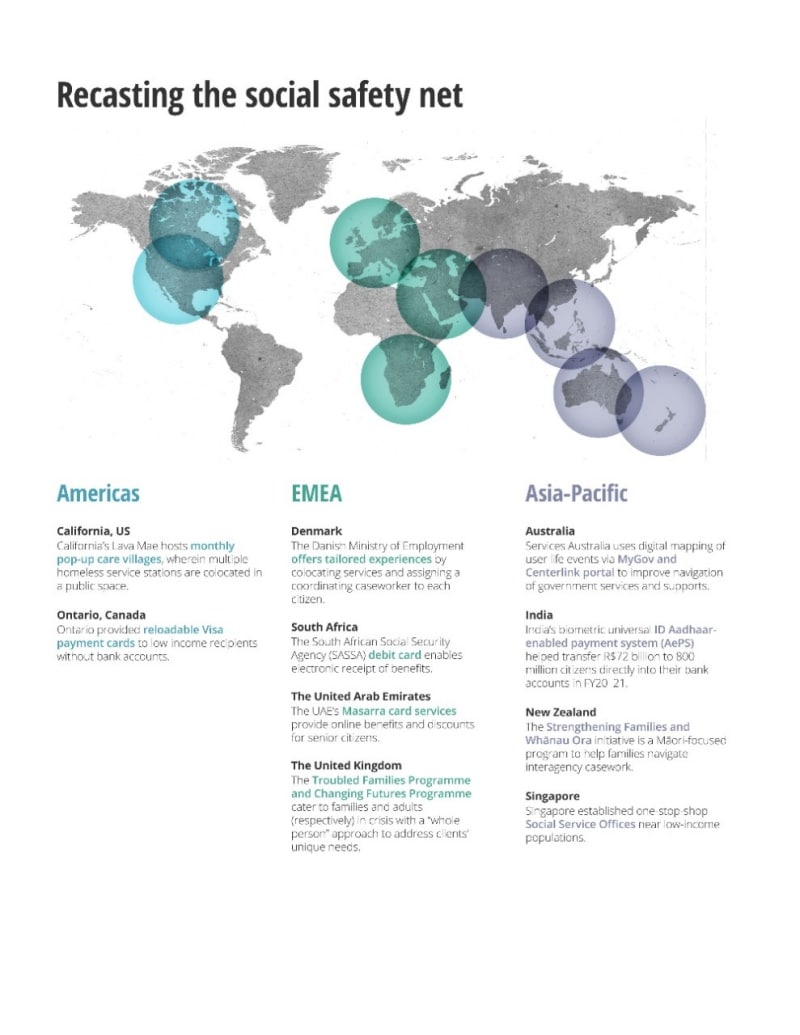Embracing integrated supports
Most social care programs are intended to provide individuals and families with temporary assistance and benefits to get them through rough patches. But it’s usually beyond their scope to attack the source of clients’ problems or address the connections among multiple challenges. To get around these limitations, some governments are establishing holistic, all-in-one supports to address physical, mental, economic, and social needs.
The United Kingdom’s Ministry of Housing, Communities and Local Government, for instance, has adopted a multiagency approach to match clients with services appropriate to their unique needs. Its Troubled Families Programme provides each participating family with a caseworker who coordinates with various support agencies as needed, while its Changing Futures program relies on cross-sector partnerships to deliver coordinated and integrated services for individuals.13
New Zealand’s government is improving service coordination through its Strengthening Families program as well as its Māori-focused Whānau Ora initiative. Both assign caseworkers to families that use more than one social service to help them navigate available programs and ensure appropriate access to wraparound support services. Results suggest that clients using these services have enjoyed better employment outcomes, greater stability, and more independence.14
Denmark’s Ministry of Employment service delivery model factors in each person’s ability to work. Those deemed job-ready and fit to work in their assessments receive traditional caseworkers. Those whose return-to-work timelines are more extended or whose situations are more complex are assigned coordinating caseworkers who work with other government agencies to ensure access to the most appropriate suite of services. Coordinating caseworkers aim to give each applicant a unique combination of employment assistance, social services, and benefits.15
Technology is helping government create integrated care journeys, while also supporting self-navigation for those with multiple needs. Online portals called “community resource engines,” for example, can suggest suites of complementary resources for residents seeking help with housing, food, employment, or other issues. These portals use artificial intelligence to prescreen applicants, direct them to the appropriate benefits, and trace the results from end to end.16 They can track users’ social determinants of health, give community partners tools to manage referrals for their services, help caseworkers coordinate care, and allow residents to provide feedback on their circumstances.
Increasing community resilience
Policymakers and providers increasingly agree that resilience is an all-important goal for social care.17 That requires investment in communities and natural support networks, whether extended families, faith communities, local nonprofits, or neighborhood groups.18
Family and Natural Supports (FNS) programs focus on strengthening relationships between young people and adults who care about them—a parent, grandparent, aunt, uncle, sibling, neighbor, teacher, or coach—through counseling, mediation, or skill-building. Relationships with the right individuals can help keep young people connected to schools and communities and create networks they can draw upon throughout their lives.19
Canada’s 2016 Without a Home study found that more than three-quarters of 1,103 homeless youths surveyed cited poor relationships with their parents as a key reason for leaving home. More than 70% of them still contacted a family member at least once a month, however, and wanted to improve their relationships with their families.20 Covenant House in Toronto operates an FNS program that offers intensive clinical support and case management to help young people reconnect with family members safely.21
Governments looking to bolster community resilience also seek data about what’s going well for communities. Too often, the focus is on problem areas: lost jobs, criminal convictions, homelessness, and hunger. Less attention is paid to how many elderly people are driven to medical appointments by volunteer drivers or how many previously unemployed persons find stable jobs.
Strengths-based data collection considers community assets and the positive aspects of people’s lives. Shifting the focus to what’s right can identify untapped or underused community resources and assets. In Whitesburg, Kentucky, for example, a community partnership called the Letcher County Culture Hub builds on local assets to improve community capacity and wealth.22 The organization has helped start new local businesses and expand others; helped local artists, farmers, teachers, and others use their skills to generate revenue; and revived two local, money-making cultural institutions: a square dance and a bluegrass festival.23
By giving communities and families resources they can use to care for themselves, social care agencies can nurture resilience rather than dependency—and help communities better withstand future shocks.















